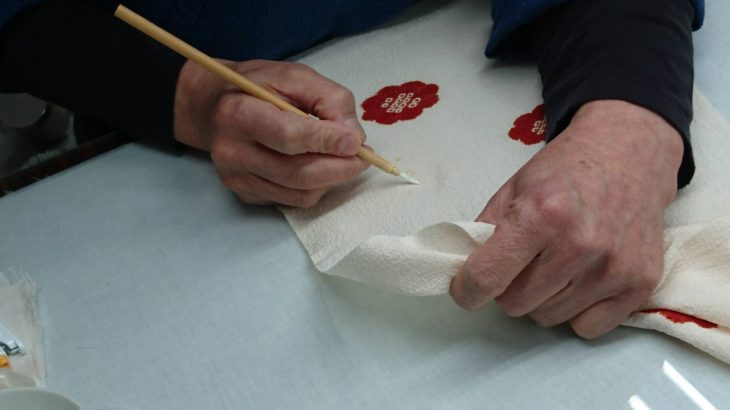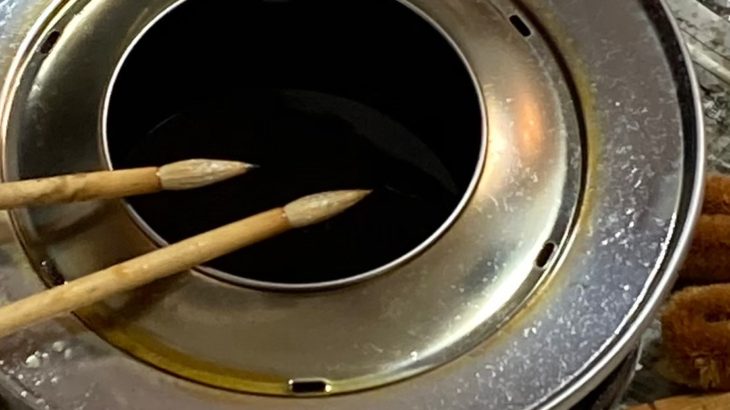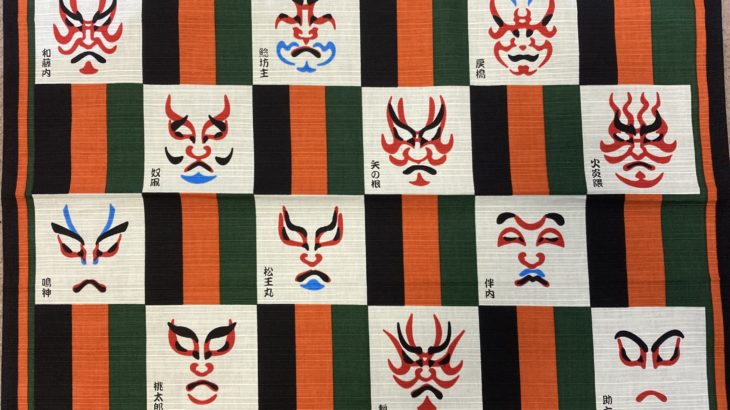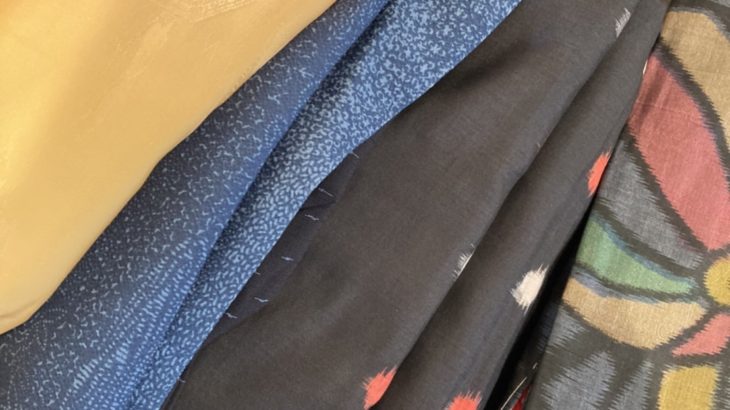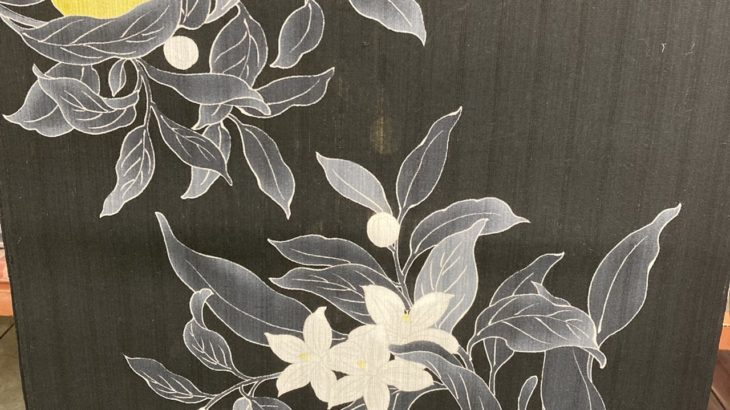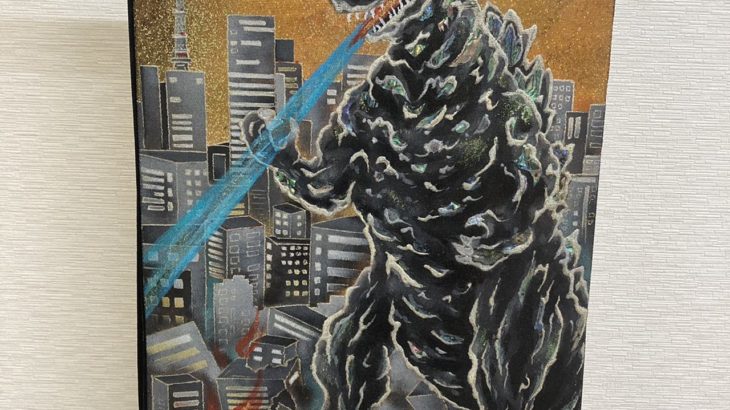Hello, this is Shinji from “Warashibe-choja.jp”. Can you take care of Kimono overseas the other day? I went to consult with a craftsman. This time I would like to summarize the stories I heard at that time.
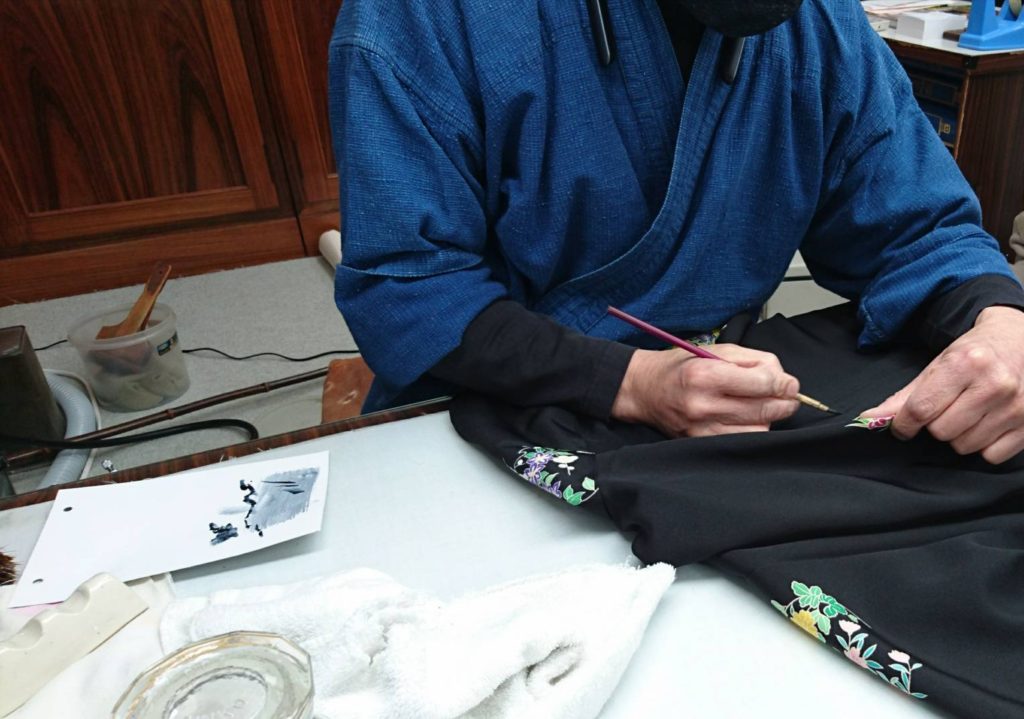
1, What is stain removal?
*Stain in the text = dirt.
“Stain removal” mainly removes stains on fibers. Here, we are talking about physical means rather than scientifically treating with chemicals.
The stains are roughly divided into “oil-based”, “water-based”, and “mixed both”. Simply put, “oil-based stains are benzine,” “water-based stains are water,” and “mixed stains are benzine and water.” First of all, it is important to determine what the components of the stain are and to correctly judge what can be removed.
・ Foundation and other oil stains can be removed with benzine.
・ You can use water to remove the water type and sweat that flew when you wash your hands.
・ Foods are often mixed with oil and water, so first remove the oil with benzine and then wash it off with water.
It’s easy to express in sentences, but it can be difficult and irreversible. In order to prevent that, I will introduce a little detail this time.
The principle of removing stains is classified into three categories, such as “washing out stains from the fabric” with water or solvent, “transferring them to other fibers”, and “scattering them widely around”. When working, you must take great care not to damage the fabric or dyeing process, and also to prevent new ring stains. The stain removal work will do them consistently.
Don’t heat the stains
There is a process called heat processing in the production of dyed products. By applying heat, the dye is colored and fixed. Similarly, if heat is applied to the stains, they will settle on the fabric and become difficult to remove. In other words, do not iron with stains or sweat. In particular, animal proteins such as blood tend to clot, so be careful. At dry cleaning stores, etc., the press may be applied without removing stains, so you need to be careful when choosing a store.
2, Silk fiber
*Let’s understand silk before removing stains.
Silk fibers have the property of swelling when they contain water. Friction on this swollen fabric is prone to ”Su‐re” and is very fragile.
What is “Su-re”?
It refers to the state in which the fibers are turned over and damaged by friction. Since the surface of the fabric is fluffy, it looks whitish due to diffused reflection of light. In other words, if you rub the fabric with a wet towel etc., the fabric will be damaged and will not heal. It also makes it easier for stains dissolved by water to penetrate deep into the fibers. Keep in mind that wetting silk with water increases the risk. Since benzine is a solvent, silk does not swell. However, please note that benzine and fibers may contain water when the humidity rises, such as on a rainy day.
3, Care with benzine
At home, benzine is safe for fabrics. However, benzine is highly flammable and may cause a fire, so be careful not to use fire. Other caveats are also explained.

Precautions for using benzine
① Vaporized gas is generated when working with benzine. Remember that gas is more flammable than liquid.
② Since gas is heavier than air, it crawls on the floor. When working, open the doorway to improve ventilation, and then use a fan to let the gas escape to the outside.
③ The use of fire is prohibited even where the gas flows. The ventilation fan at the top is meaningless.
④ Be careful of sparks from electric switches and outlets.
⑤ Static electricity sparks during work are the most dangerous. Avoid synthetic clothing such as polyester.
⑥ For benzine, use a stable container with a closed lid.
⑦ “Be careful! 』 Let’s assume the worst situation and put a fire extinguisher nearby.
Now that we know the dangers of benzine, let’s get back to work. Benzine is effective for light stains and oily stains. However, there are limits to dark lipsticks. In that case, I think it is better to leave it to a professional. At this time, some people think that it is better to make it as thin as possible with benzine. However, if you do not drop it all at once, it will get into the fiber with benzine and it will be difficult to drop it. The only thing you can do at home is to treat the dirt on the foundation and the dirt on the cuffs.
4, How to remove the foundation on the collar
Preparations
Benzine, bleached cotton, rolled straw (brush for benzine)
Procedure
① Wet the collar with bleached cotton soaked with plenty of benzine. If you blur the collar to the full square, the mold will not be attached.
② Brush in the vertical direction according to the shape of the collar with brush for benzine soaked with plenty of benzine.
③ Look at the time when it fell off, soak the bleached cotton with benzine, wipe off the dirt, and blur it well.
④ For drying, wave the collar so that the flag flutters. Or it is naturally dried. When using a dryer, apply cold air from the edge to the center. Operate the dryer switch at a position higher than benzine gas.
*Please consider ① to ③ as one process. The trick is to finish it quickly.
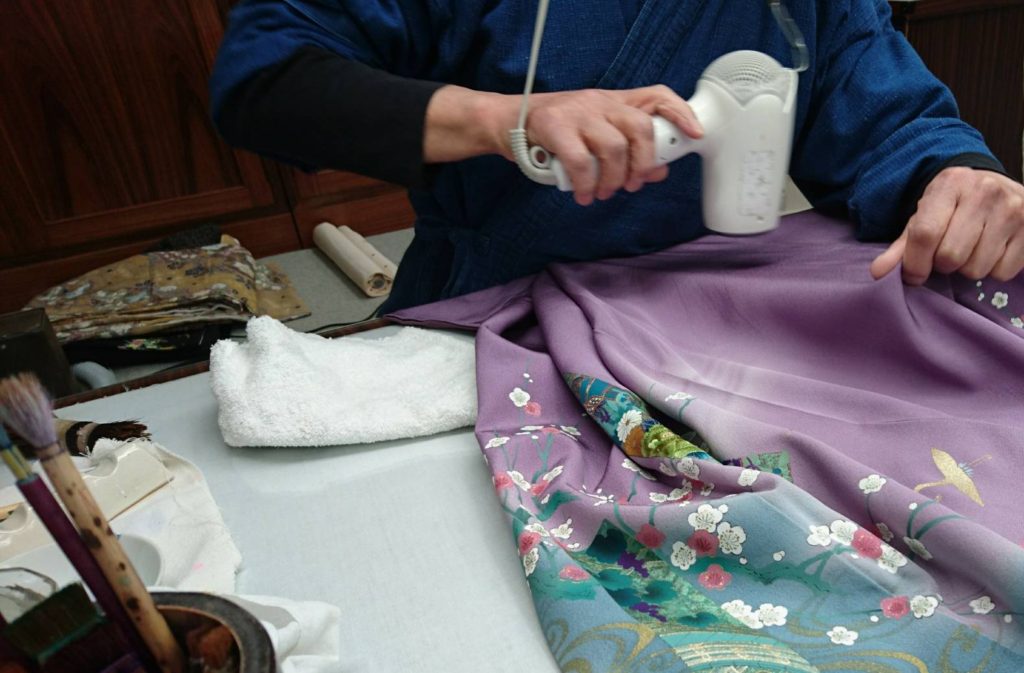
5, Work with water (not recommended)
As mentioned above, removing stains with water is not recommended as it may damage the fabric. I think that you can be convinced if you try it once with the surplus cloth at the time of tailoring. I talked with the craftsmen about the actual work, but I do not recommend it, but I will only explain it.
[ Characteristics of water ]
The water on the dough has the property of moving to dry areas. Aqueous stain removal uses this principle. In other words, moisten the stains on the kimono with water and move the softened stains toward the dry bleached cotton. Of course, the silk is swollen at this point, so rubbing is prohibited. It’s easy to do it unintentionally, but be aware that pressing the stain with a wet handkerchief or hand towel will result in the stain being pushed deep into the fiber along with the water.
[ Countermeasures against ring stains caused by spraying ]
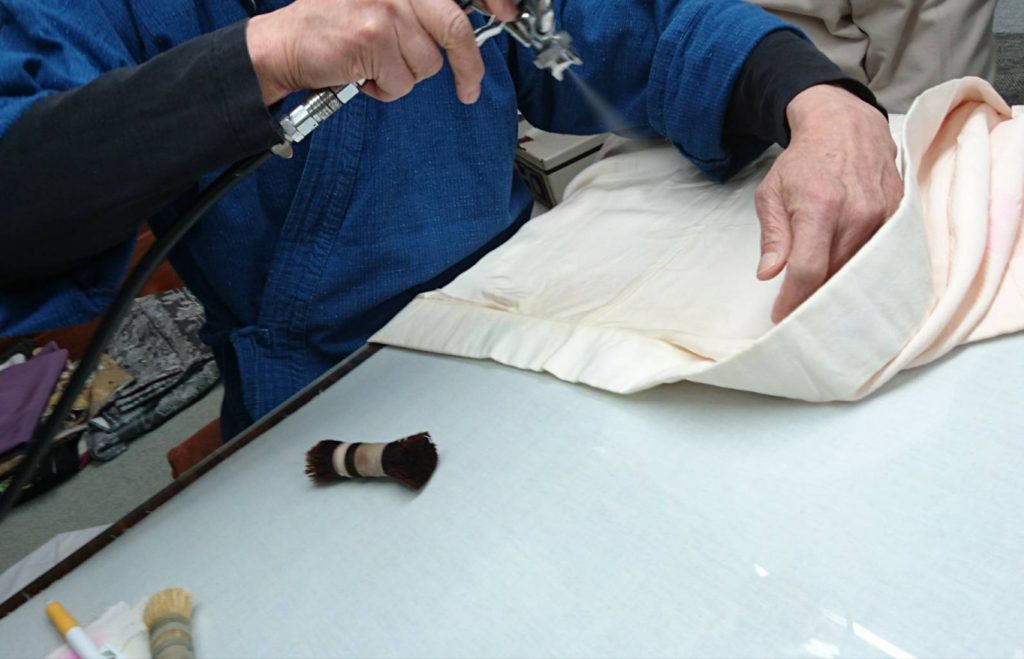
A spray bottle is indispensable for working with water. That is because it does not create a new ring stain. Craftsmen use an airbrush to spray a fine mist of water. If the water fog is rough, it may cause new stains. We recommend L-shaped spray bottles at home. Introducing the range of care that can be done at home with an L-shaped spray bottle.
1, Repairing water stains made from splashes
After spraying with a fine mist, it may disappear by natural drying. You can iron it if you are sure it will disappear. However, it is important not to shrink and to prevent Ki-se (= Fullness) from disappearing. You need to practice with extra cloth until you get the hang of it.
2, Measures against sweat stains
It is not desirable to say, “After wearing it, let it dry to eliminate sweat.” Sweat disappears when it dries, but the ingredients remain. This will turn yellow in the future. Also, dry cleaning does not remove sweat. Of course, even benzine cannot be dropped. Sweat is water-based and cannot be removed without using water.
It is important to treat sweat as soon as possible after returning home
① Let’s hang it on the kimono hanger inside out.
② Sprinkle water mist from the back on the side or back where you think you have sweated.
③ If you get a sweat pattern, use dry bleached cotton to hold it down. If it doesn’t work at once, repeat it twice or three times.
④ If the back is terrible, the outer material may be perspired. In that case, spray water mist from the front side, hold it between both sides with bleached cotton, and move the sweat to the dry bleached cotton.
*At this time, be careful not to rub so as not to generate Su-re.
⑤ Shrinkage due to water mist is another problem, so press processing is required in that case.
If you take care of the above when wearing it, you should be able to avoid the worry of yellowing even if you do not lose 100% of your sweat. As I say many times, to prevent Su-re, please do not rub while it is wet (especially the outer material). However, if you sweat a lot, you may already have friction when you wear it, and your sides and back belt may be rubbed. Also, the color of the kimono may transfer to the obi, or the color of the obi may transfer to the kimono. In this case, you have no choice but to consult a professional craftsman.
6, First aid for stains
About first aid on the go
[ Mild water stain ]
If you get water stains from your hands, apply them to your palm quickly. It may disappear at body temperature within a few minutes.
[ Food stain ]
If food is attached, pick it up with dry tissue paper or a handkerchief if it is solid, and gently press it with dry tissue paper or handkerchief so that the liquid does not spread. Please do not use wet ones. Also, be careful not to rub it. After that, please consult an expert.
[ Important point ]
Finally repeat only once more. As I said in the oil stain remover, “Isn’t it cheaper to make it as thin as possible when you bring it to an expert later? Please stop thinking. Especially when water is used, there is a high risk of threading and permeating the fibers. The ideal for removing stains is to remove them all at once.
7, About management
After wearing it, it is important not to clean it up as it is, but to check for stains and take appropriate measures such as sweat removal. Ideally, you should bring it to an expert each season. Of course, choosing a store is also important. Depending on the degree, consult an expert who can provide appropriate advice.
[Precautions for storage]
It is dangerous to store it in an airtight state for a long period of time. Mold may be generated, discoloration may occur due to gas generation, and discoloration may occur due to insect repellents and fragrances. It is important to avoid airtightness with Mushi-boshi once or twice a year. Open chest of drawers and boxes on a dry, sunny day. You can prevent the generation of mold and gas by adding fresh air. However, do not expose it to ultraviolet rays. In some cases, the color of Mushi-boshi was faded by exposing it to ultraviolet rays for a long time. I can’t rest assured that the fluorescent lights in the room also emit ultraviolet rays. Please choose a well-ventilated place in the shade during the day and dry it. We also recommend opening the chest of drawers and turning on the fan.
There are many other things, but if anything happens, we recommend that you consult an expert. I can answer some questions, so please feel free to contact me.
This time, I introduced a little specialized knowledge. In the future, I would like to introduce not only kimono but also Japanese culture around me. I have created a Youtube channel, so I hope I can introduce it there as well. Please subscribe to the channel if you like.
Warashibe-choja.jp Youtube
